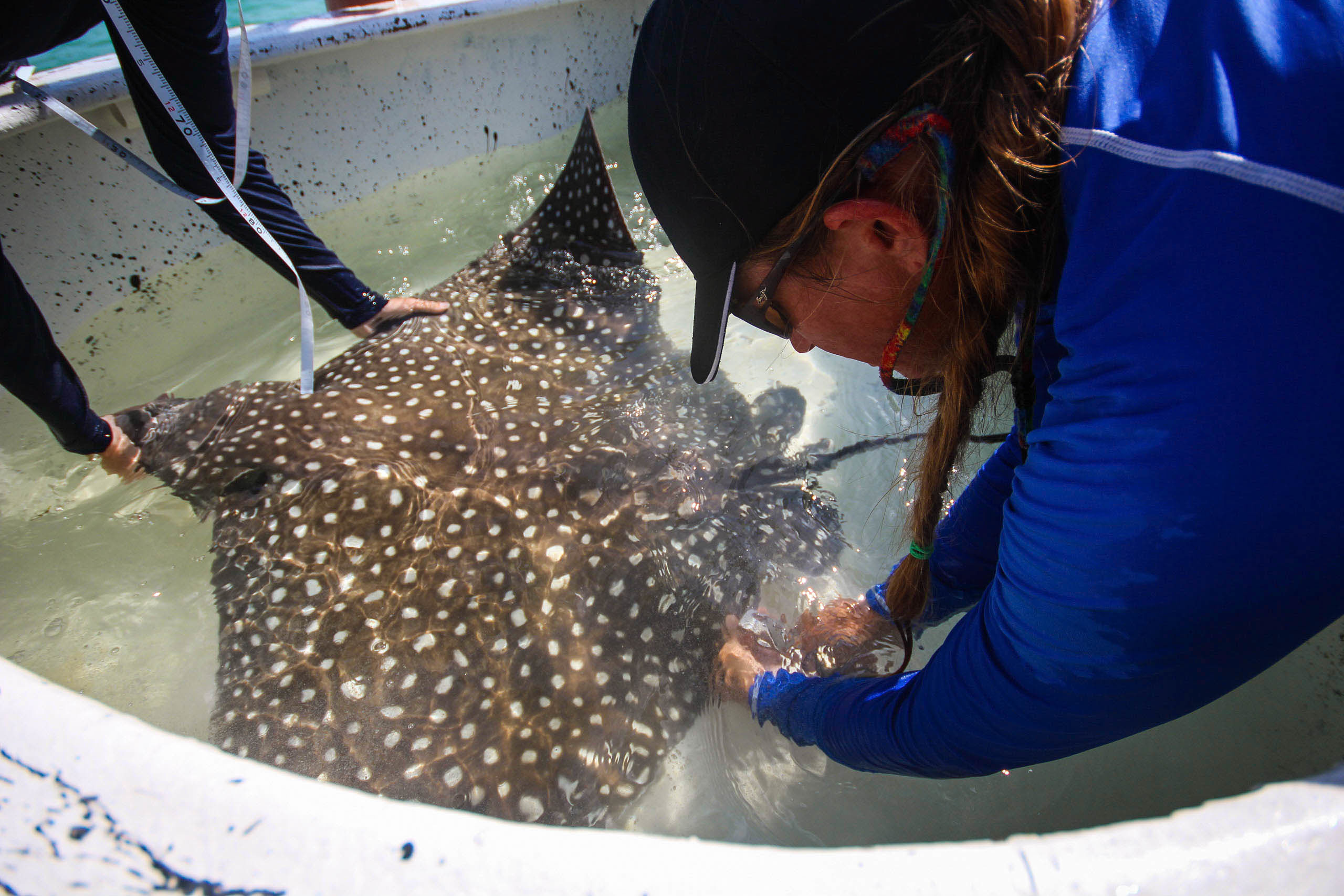Uncovering the Secret Lives of Dolphins
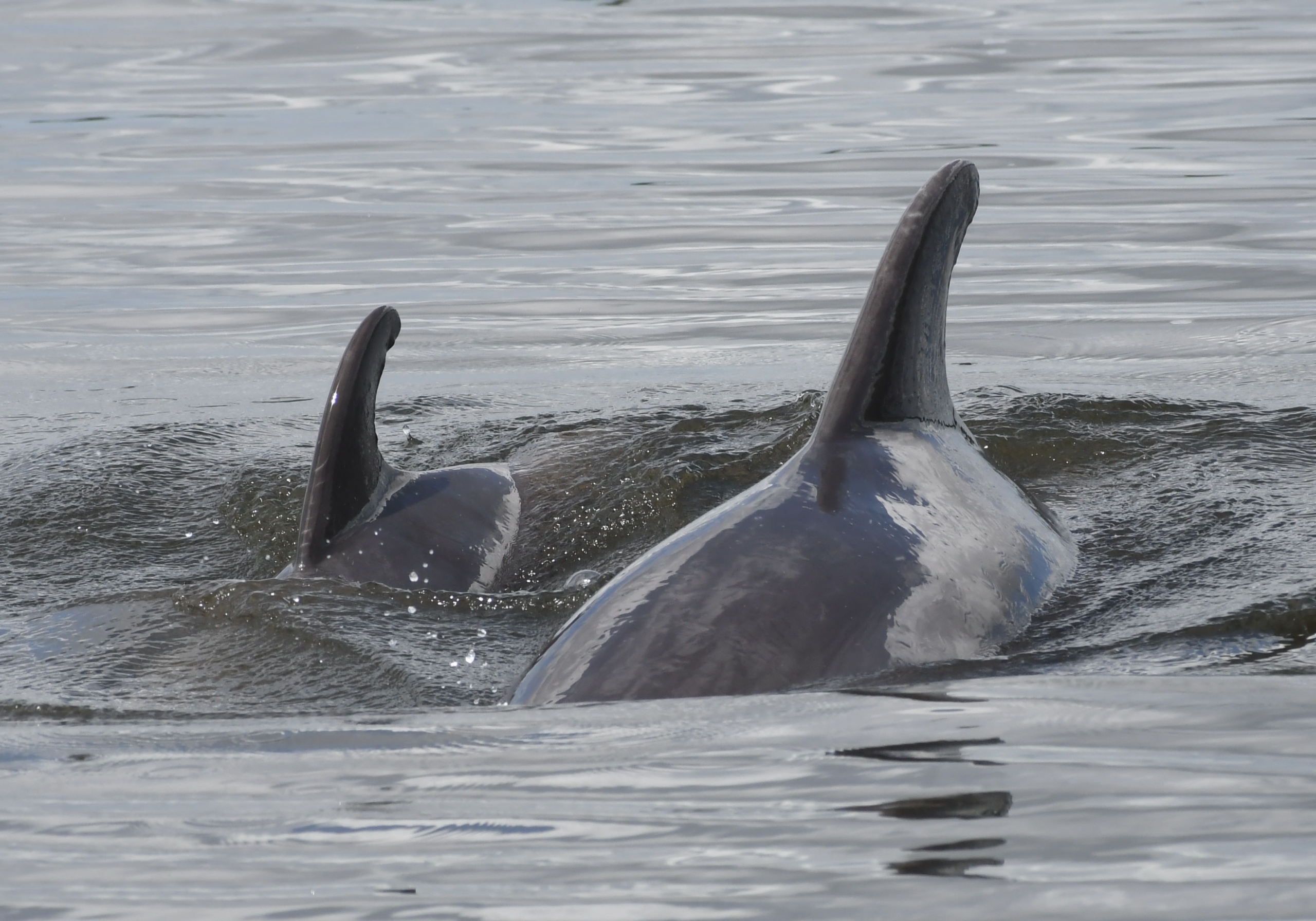
In 1970, the first question we asked about dolphins was “do they live here, or do they just pass through?” We discovered a community of long-term dolphin residents, across decades and generations, with a specific home range centered on Sarasota Bay.
This was the beginning of our recognition of the potential of Sarasota Bay as a long-term natural laboratory — a place where we could study identifiable individual dolphins in their own habitat and environment, observing their behaviors, learning about their biology, delving deeply into their day-to-day lives as individuals, gaining a greater understanding of their complex social interactions as a society, and learning about their needs in the face of increased human activity in our coastal waters.
Over more than five decades, we’ve developed and refined the methods and materials that we use to study dolphins. These are the primary approaches that we use today.
Visual Observations
Photographic Identification Surveys
During Photo ID Surveys, teams of two to five people set out in small boats to survey the study area, looking for groups of dolphins. We undertake at least 10 survey days per month in the Sarasota Bay area, to try to cover the entire study area at least 3 times. When the team sees dolphins, they record the following data:
- Date
- Time
- Location
- Environmental parameters
- The numbers of dolphins and calves, including young-of-the-year
- The animals’ activities
- Whether the dolphins are interacting with humans

We can recognize individual dolphins based on unique patterns of nicks and notches on their dorsal fins — like a human fingerprint. While most of these occur from natural causes, for example shark or dolphin bites, others are from humans — from entanglement in line or boat propellers. We can identify about 95% of the dolphins in Sarasota, most just by seeing the animals, but we take photos of the dorsal fins as the primary data for confirming identifications. We maintain an extensive catalogue of fin images so that we may confirm dolphin identities back at the lab. Our main survey coverage area is from southern Tampa Bay, including Terra Ceia Bay and the Manatee River, to Venice, and offshore to within about ½ mile of the Gulf beaches.
Monthly Photo ID Surveys are funded by the Charles and Margery Barancik Foundation
Focal Dolphin Behavioral Follows (Focal Follows)
Understanding animal behavior is about more than just making a note of every exciting or interesting thing that happens. Instead, it’s a systematic documentation of all of their behavior and activities. During Focal Follows, we follow dolphins for a predetermined period of time, recording what an animal is doing at set intervals (typically every three minutes). That allows us to put behavior into perspective relative to other activities over time.
Such non-invasive behavioral studies were developed by Dr. Jeanne Altmann, a behavioral ecologist famous for her groundbreaking studies on the social behavior of baboons.
We typically conduct these surveys using a vessel with a tower, which allows us to better see through the water’s surface, and we are integrating drones into our research to gain an even better view of the animals.
Since we began using these techniques in the 1980s, we have records of more than 2,000 Focal Follows and the information we’ve gained has allowed us to answer important questions — for instance, how much time dolphins spend feeding or socializing compared to other activities. Having this baseline information allows us to detect unusual behaviors or problems.
Identifying Dolphins
Our Dolphin Identification Catalogue contains images of more than 5,000 distinctive individual dolphins from our work along the west coast of Florida, from Sarasota and the vicinity, as well as Tampa Bay, Lemon Bay, Charlotte Harbor, Pine Island Sound, Naples, Marco Island, and the adjacent Gulf of Mexico waters out to about 5-10 miles.
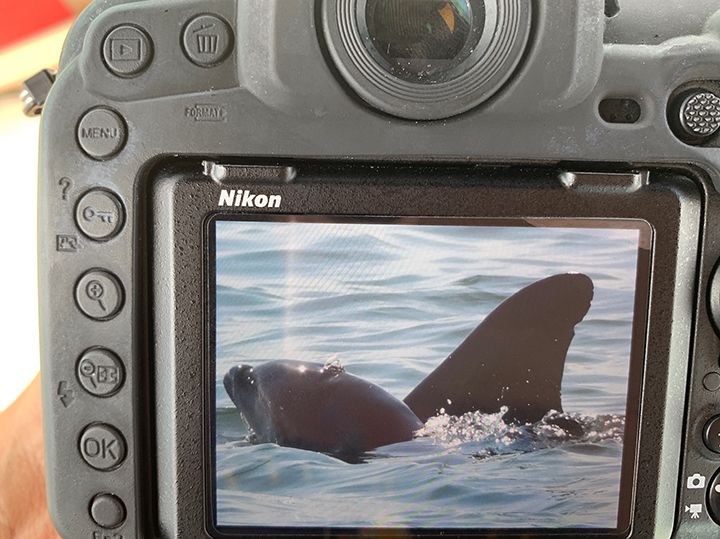
We use automated fin-matching software that helps us to determine a dolphin’s identity by presenting a selection of the most likely candidates in just minutes, compared to the nine hours it used to take to scroll through catalog images individually. Final determinations of identities are still made by the experts.
The SDRP also curates the Gulf of Mexico Dolphin Identification System (GoMDIS), which combines, standardizes, and serves as an online archive for dolphin ID catalogues from groups throughout the Gulf of Mexico — including Mexico and Cuba. This repository allows us to identify dolphins throughout the Gulf and discover changes in ranging patterns or even determine the origin of a stranded dolphin. GoMDIS also makes use of automated fin-matching software.
Today, GoMDIS contains:
- 35 dolphin ID catalogs
- 23,444 individual animals
- 41,492 images
GoMDIS is funded by the Florida RESTORE Act Centers of Excellence Program RFP III, through Mote Marine Laboratory
Acoustic Studies
Communication Studies
In collaboration with numerous colleagues over the past 35 years, our dolphin communication research team has collected thousands of hours of acoustic recordings from members of the resident Sarasota bottlenose dolphin community, with a focus on individually distinctive signature whistles.
Recordings have been made during periodic health assessments, when we are able to obtain high-quality recordings of known individual dolphins.
We are currently in the process of systematically assembling a verified signature whistle catalog, with multiple samples from each of the approximately 1,000 unique recording sessions of almost 300 individual dolphins. Members of this collaborative team, and our student researchers, come from Woods Hole Oceanographic Institution, the University of North Carolina Wilmington, University of St. Andrews, and Hampshire College.
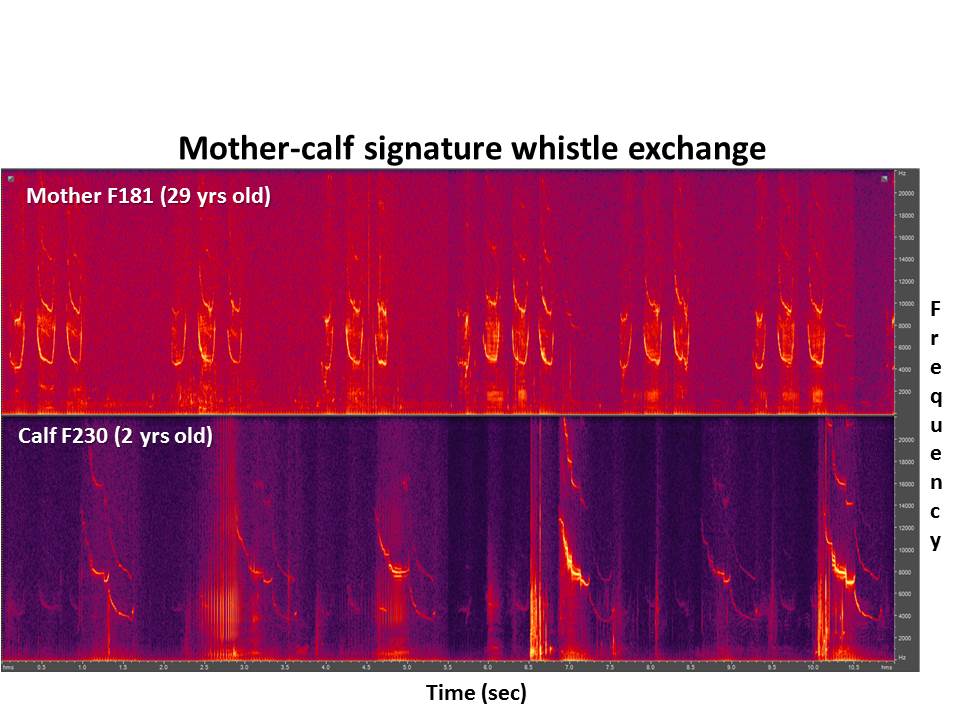
The image above visualizes the signature whistles of two different dolphins. As you can see, the shape of the whistle produced by the mom is different from that produced by the calf. Since each dolphin has an individual signature whistle, we can use our catalogue of sounds to determine which dolphins were recorded near a specific hydrophone.
Passive Acoustic Listening Stations (PALS)
SDRP has a network of underwater listening stations in Sarasota Bay; each station includes a hydrophone that records sounds to flash memory cards and/or transmits data via cell phones. These stations allow us to explore the underwater acoustic environment of Sarasota Bay to better understand the ecological dynamics of the Bay and the behavior of its animals, including sound-producing fish, dolphins and manatees.
We created PALS in partnership with David Mann of Loggerhead Instruments, Mote Marine Laboratory, New College of Florida and local citizens who have allowed us to put stations at their docks. Recently, Eckerd College joined us as well.
Because these instruments collect so much data — many terabytes each year — our partners at New College have developed an automated system of identifying bottlenose dolphin whistles. So far, we’ve identified nearly a quarter of a million distinct whistles, and, because of work done by our partners at WHOI and the University of St Andrews, Scotland, to develop a Sarasota Dolphin Whistle Database of the unique identifying sounds that each dolphin makes, we can even tell not just when dolphins are present near these stations, but which dolphins they are.
We’re always working to add new stations and improve our capabilities. In the summer of 2021, we upgraded half of our 10 Sarasota Bay listening stations to a more powerful version from Loggerhead Instruments called HaikuMarine, which runs a continuous neural network to detect dolphin whistles. The sounds detected are instantly uploaded to a website where we can listen in!
One of these stations is located at Marie Selby Botanical Gardens Historic Spanish Point campus, and is paired with a Science and Environment Council Watershed Audio Tour stop about Sarasota Bay Dolphins and interpretive signage about sounds in the bay, which connects visitors to audio clips recorded at the site.
Interested in hearing what we’re hearing? Visit Haiku Marine and listen in to the underwater world!
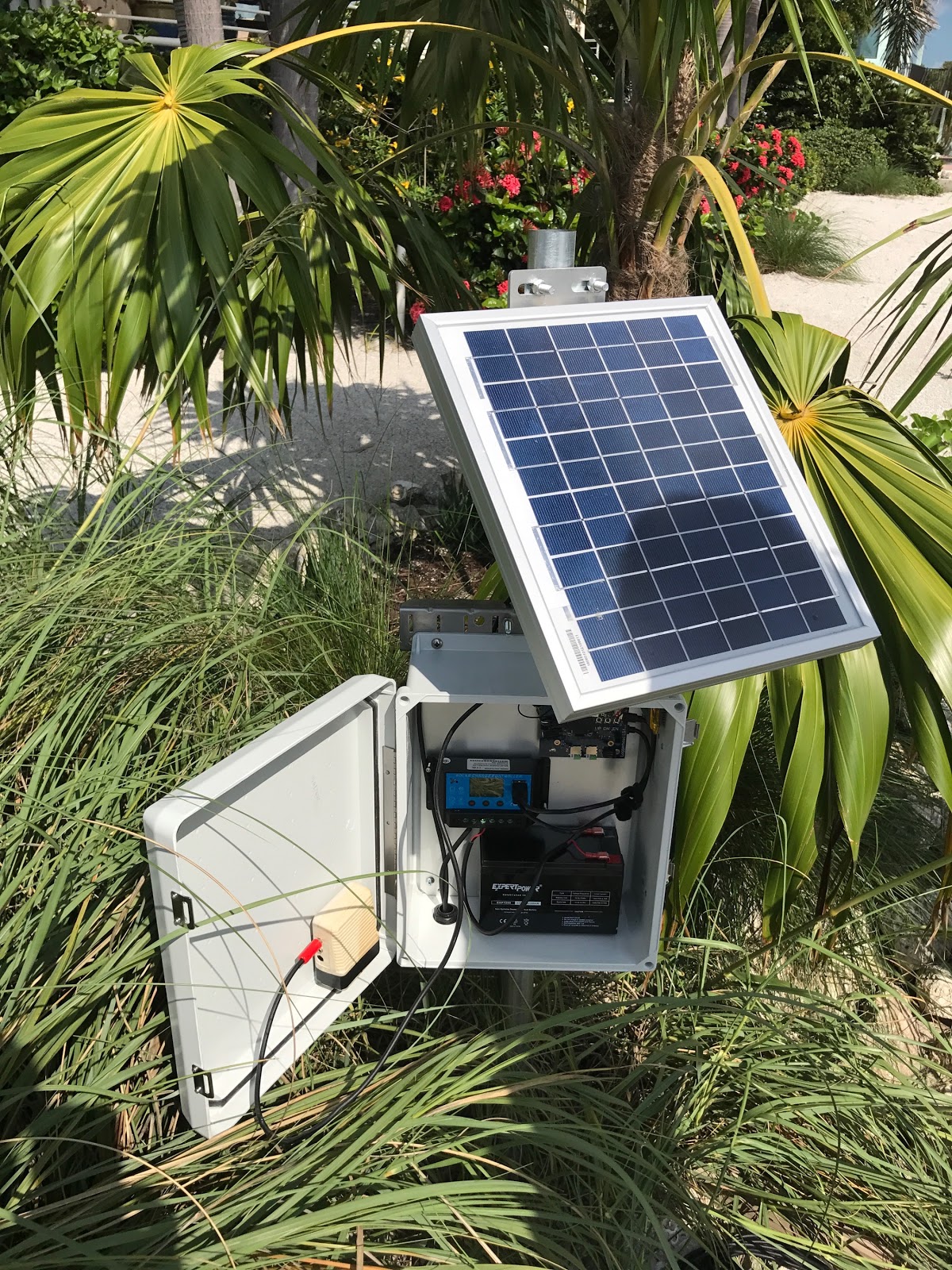
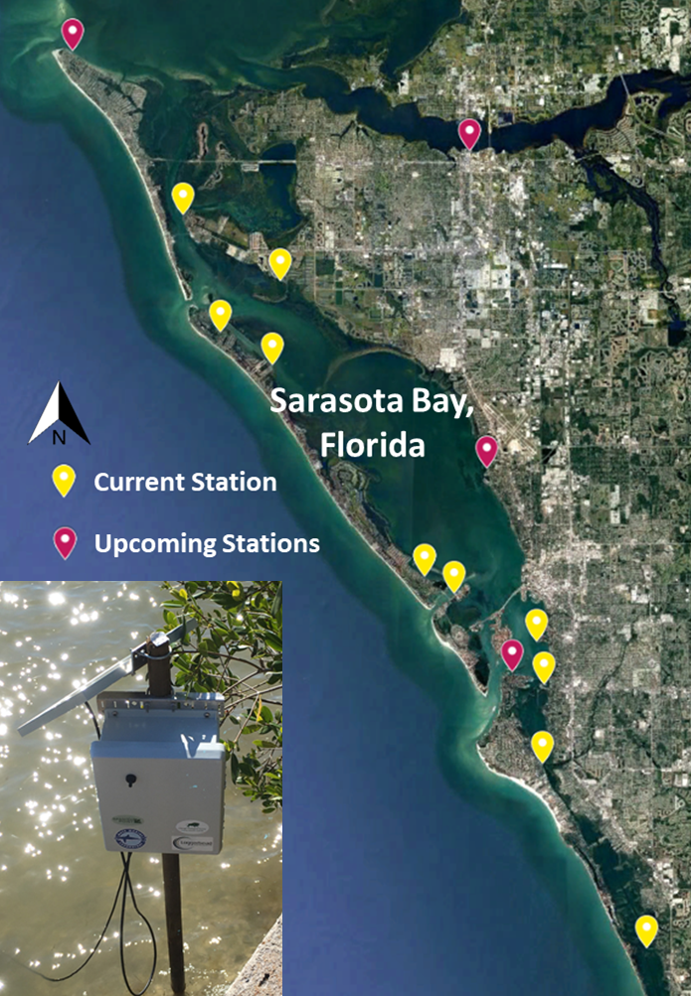
Dolphin Health Assessments
We assess dolphin health in several ways: observations, biopsy dart sampling and capture-release studies.
Observations
Often our first indication of health issues for individuals come from observations during surveys. We document dolphin condition photographically, with video, and through monitoring other parameters such as respiratory rates. We will soon be incorporating drone imaging into our health assessment toolbox.
Biopsy Dart Sampling
We use a crossbow to to remotely obtain a small biopsy sample — slightly larger than a pencil eraser — from individually identifiable dolphins. This is a standard dolphin research technique that has been used very effectively tens of thousands of times around the world. From this tiny sample we can learn:
- A dolphin’s sex, approximate age, genetic relationships;
- Concentrations of environmental contaminants;
- Concentrations of reproductive and stress hormones;
- Nutritive condition from lipid content;
- Diet information from fatty acids and stable isotopes.
Capture-Release Studies
During these studies, small groups of dolphins are encircled with a net in shallow waters. The animals are brought aboard a special veterinary exam vessel and placed on pads on a shaded deck. Teams led by veterinarians then examine the animals and gather biological samples. After a brief period, the animals are released on site.
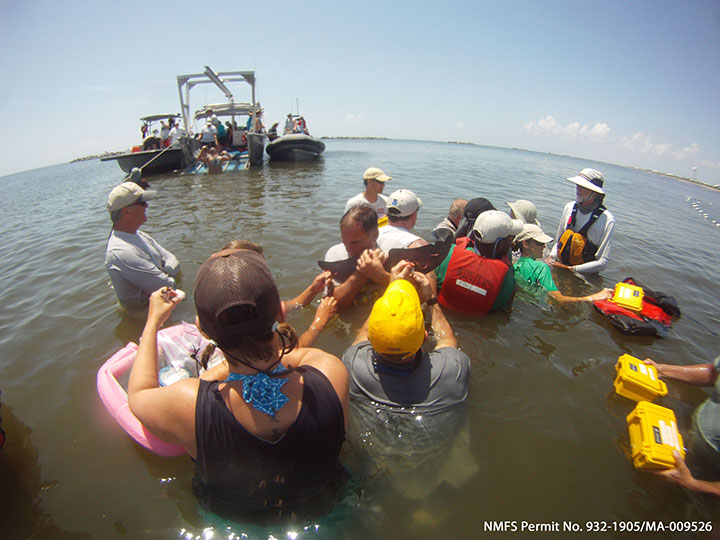
During these health check-ups, veterinarians and biologists gather basic information — sex, weight, length — and conduct physical exams. They also conduct ultrasound examinations to determine reproductive status and check the condition of internal organs, and take blood and other biological samples. Health assessments have been conducted periodically since 1988, as scientific questions warrant, and as financial support has been available to mount the effort — which often includes more than 100 researchers and support team members and a dozen vessels over five to 10 days.
The data collected during Sarasota health assessments has been used to develop medical reference ranges, to understand normal ranges of health parameters, that help for detecting problems when measures occur outside of these norms, as was the case for investigations following the Deepwater Horizon oil spill.
During any given health assessment, we gather information for dozens of different research projects. These projects often include development and testing of new diagnostic tools that improve our knowledge of the health of dolphins in the wild, as well as benefitting dolphins under human care.
Before the dolphins are released, we may also attach tags or freeze-brand them. A freeze-brand is like a medical ID bracelet and provides an unambiguous way to identify dolphins in the future and link their identity to specific medical records.
Ecological Studies
Gaining a fuller understanding of dolphins also means studying how they interact with their environment, including other species in their environment (even humans). As with most animals, there are two main ecological drivers for dolphin behavior: prey and predators.
Fish Surveys
Fish surveys help us gain an indication of the relative abundance of fish in Sarasota Bay. Since 2004, we have used standard purse seining techniques in sea grass meadows on a seasonal basis (10 sets per month from January-March and June-September) to sample fish in a measureable volume of water. Each fish is brought aboard, identified by species, measured and then released alive. We also collect environmental measurements, including water temperature, depth and salinity, and dissolved oxygen, as well as a water sample to check for concentrations of Karenia brevis, the phytoplankton that causes Florida red tide.;
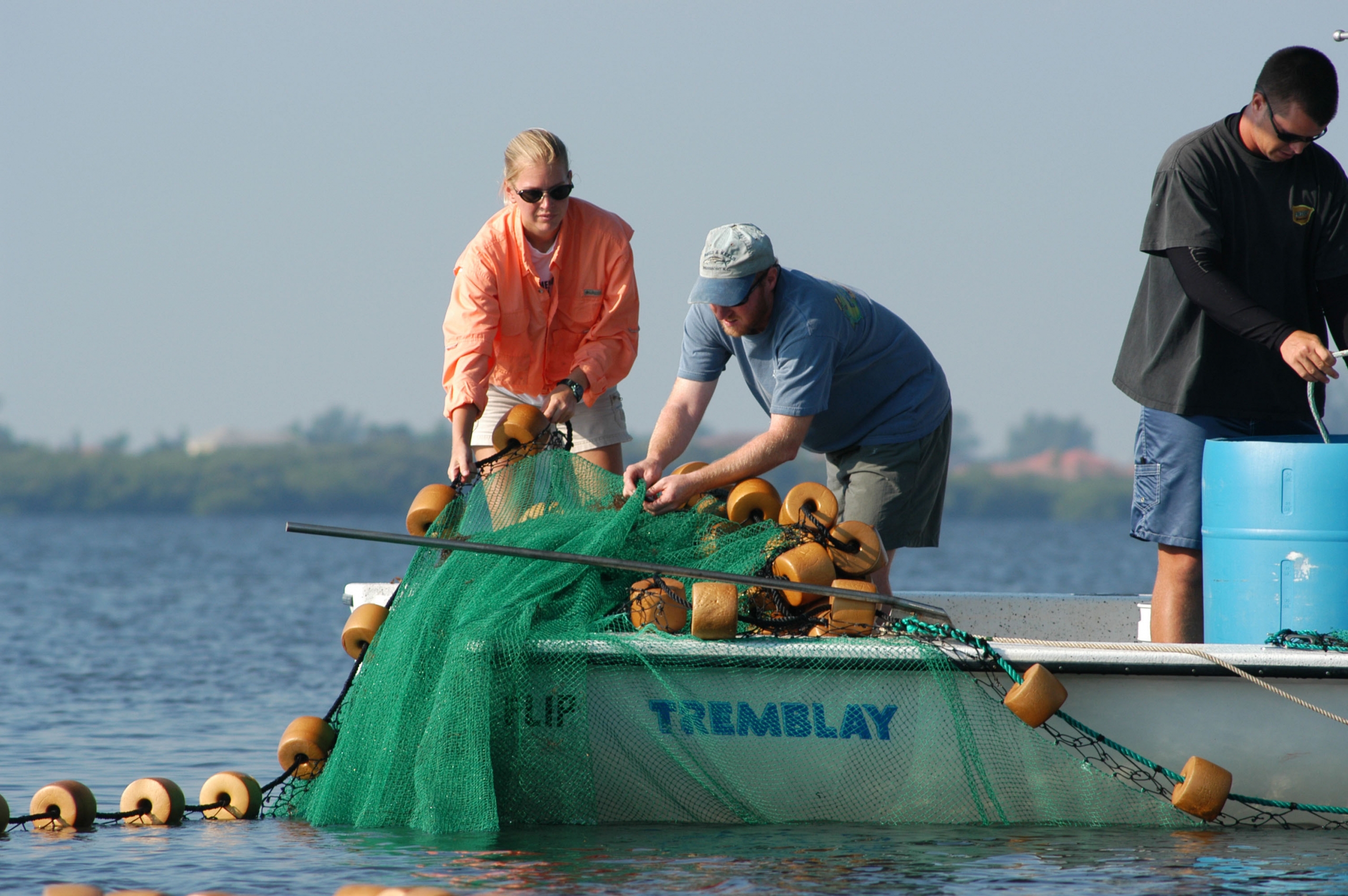
We also collect environmental measurements:
- Water temperature, depth and salinity;
- Dissolved oxygen;
- We also gather a water sample to check for concentrations of Karenia brevis, the phytoplankton that causes Florida red tide.
Fish Surveys are funded by the Charles and Margery Barancik Foundation
Shark Research
Sharks — particularly bull sharks — are dolphins’ main predator in Sarasota Bay and vicinity. In a collaborative effort with Mote Marine Laboratory’s Center for Shark Research, we undertake shark-tagging with acoustic and satellite-linked tags to determine the movements and habitat use of predatory sharks. Part of these studies is quantifying the presence of shark bites on dolphins using information gained during Photo Identification Surveys. Our efforts also include taking biological samples from tagged sharks to determine what they’re eating and where prey species may overlap with those of dolphins.
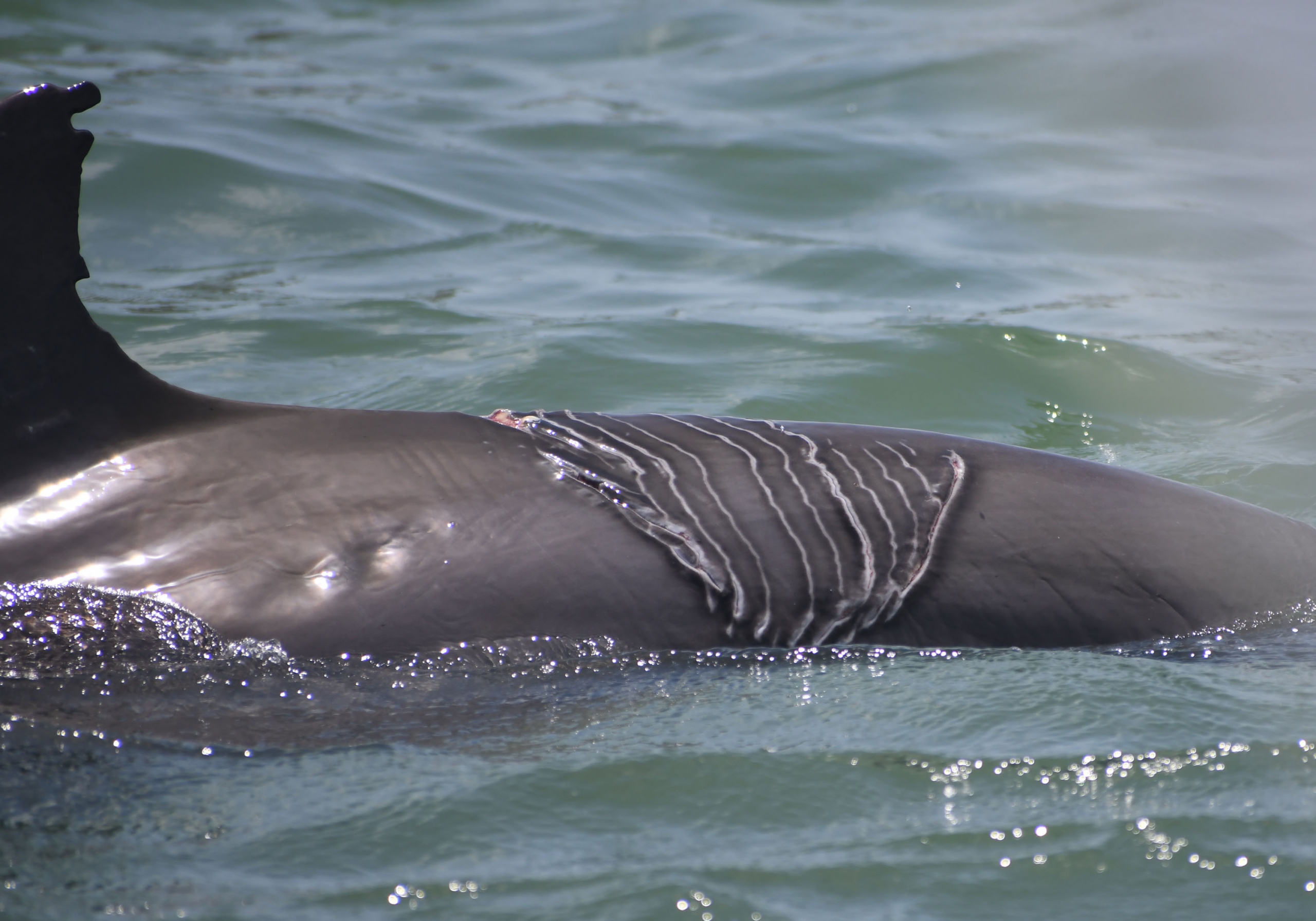
Spotted Eagle Ray Research
This collaborative effort with Mote Marine Laboratory has been studying the life history, ecology and conservation status of another large marine animal in Sarasota Bay — spotted eagle rays.
